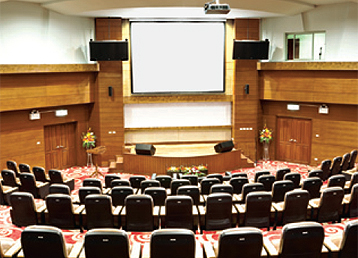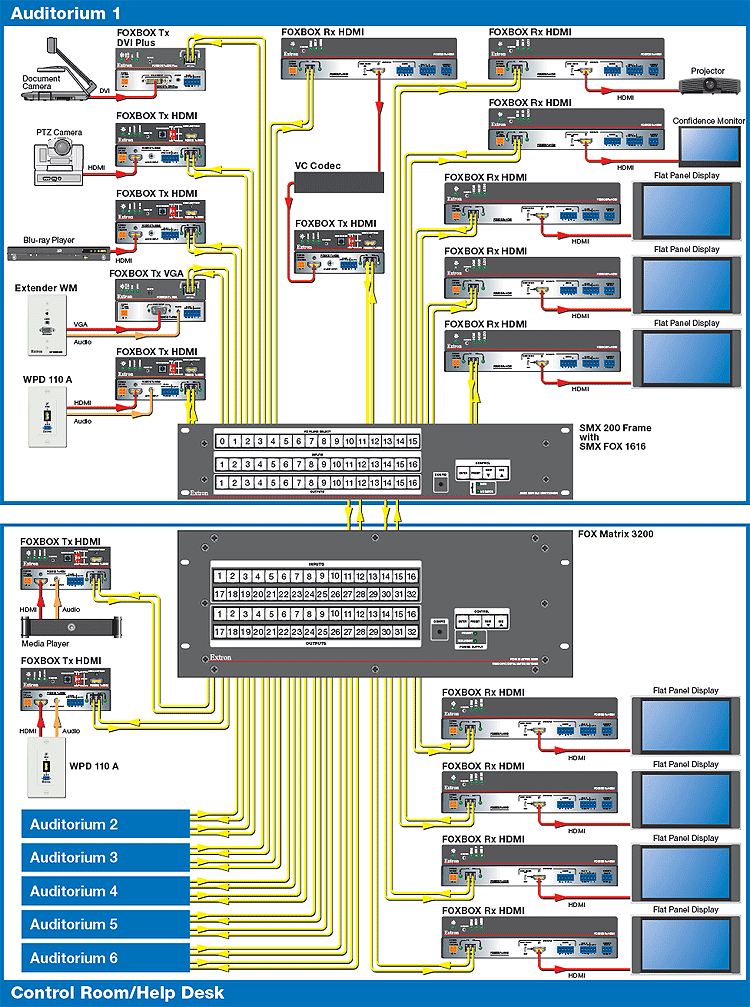System Design Solution

A local University is looking to expand its course offerings at its remote sister campuses. They’ve decided that a distance learning environment will allow the current faculty to instruct students that are located across the entire state. This will allow them to have a greater impact on the communities that host the remote campuses without placing an increased burden on their staff. They would like to connect multiple auditoriums on the main campus with a head-end monitoring system that will also be connected to a lecture hall on each remote campus. Wherever feasible, the system should allow for digital connectivity and support of current and future source devices that incorporate HDCP protection. Additionally, the course material and presentations will be archived for playback in the event that students miss a class.
Display System
The main display is a large venue projector with a native resolution of 1080p. It is installed at the rear of the auditorium and fills a fixed screen that is approximately 150" diagonal. The flat panel displays are also 1080p native in order to minimize aspect ratio conversion and signal processing. These are installed on the side walls to supplement the main screen. The final display in the system is a 1080p LCD monitor located on the rear wall of the student seating area. This display duplicates what is shown on the main screen and allows the instructor to see the content that is being presented while facing the students.
Cameras
There are multiple cameras installed throughout each auditorium. These are connected to an Extron FOXBOX Tx HDMI so that the signal can be extended and ultimately, routed to the Lecture Capture system as well as the Video Conference CODEC.
Switching & Signal Management
An Extron SMX 200 with SMX FOX 1616 fiber optic matrix board handles the local routing and signal distribution for the sources located in the lectern of each auditorium.
Lectern Sources
Each lectern source is connected to an Extron FOXBOX Series transmitter. Legacy analog sources are supported with a FOXBOX Tx VGA while the digital sources use either a FOXBOX Tx DVI Plus or a FOXBOX Tx HDMI. This approach provides the highest level of flexibility and allows for intelligent management of source resolutions and HDCP key negotiation.
Signal Distribution
Each display in the auditorium uses an Extron FOXBOX Rx HDMI to ensure pixel perfect video throughout the system. These units also maintain the HDCP encryption of signals so that the entire system is compliant, thus ensuring that any source will be viewable on any HDCP compliant display.
The local SMX 200 is interconnected to an Extron FOX Matrix 3200 in the head-end monitoring location. This fulfills the requirement of monitoring the content that is being viewed within each auditorium and also allows the Lecture Capture system to be distributed to the auditoriums. By using a fiber optic backbone, the signal integrity is maintained and collaboration can occur seamlessly.
| Room Needs Assessment | |
|---|---|
| Staffing | Instructors will use multiple sources throughout the presentation. Typically, this includes the professor’s personal laptop, document camera, Blu-ray player, and Video Conference CODEC. Additionally, University support staff on the main campus will monitor and provide assistance from the head-end location to all auditoriums. |
| Source Locations | Computer inputs and document camera will be located at a teaching station at the front of the room. Physical media will be played on a local Blu-ray player. Video Conference hardware is located in each auditorium so that any location can participate or serve as overflow for special lectures. |
| Display Requirements | The main display for the auditorium is a large venue projector. In order to accommodate students who do not have ideal sight lines to the main screen, three additional flat panel displays are strategically located. All displays should be HDCP compliant and utilize a digital connection to the infrastructure in order to facilitate growth and upgrades. |
| Functional Requirements | Classroom presentations and instruction are intended to be recorded for archiving and distribution to the head-end location. Cameras located within the auditorium will be focused on capturing the instructor as well as the students during the participatory portions of the class. |

 Chrome
Chrome
 Firefox
Firefox
 Edge
Edge
 Safari
Safari